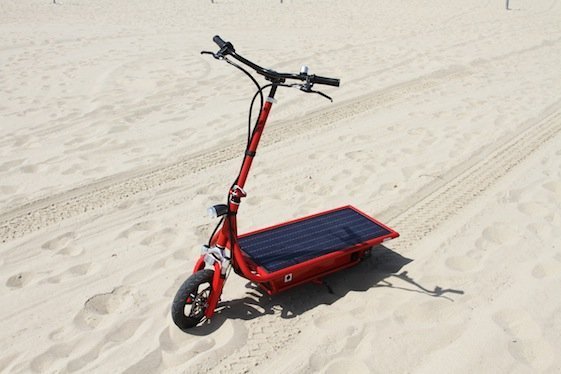For people who may have short daily commutes, electric scooters are now more common modes of transportation. One of several areas that solar technology has focused on is the e-scooter market, which has been targeted at being good for the environment from the outset. Coal, oil, and other dirty processes are still utilized to charge EV batteries, as proponents of fossil fuels.
The development of feasible alternative energy vehicles will benefit the environment. Because combustion engines cannot reach full combustion, the unwanted gases produced contribute to the global warming problem. As electric motors generate no emissions, the use of urban electric-powered vehicles would significantly reduce the quantity of carbon dioxide (CO2) that contributes to global warming. All of that may change if so many scooters are powered on solar energy. So, in this article, we will dive into where the solar electric scooter started, their advantages, and the new lightweight electric solar scooter.
Solar Electric Scooter: From Where It All Began
Mike Donnell and Tony VanMeeteren created a startup in 2013 with the goal of putting their solar scooter into production. To do so, they started a Crowdfunding campaign to gain $100,000 in startup funds. The platform of the Solar Electric Scooter is a completely functional solar panel that captures the sun’s energy to power the scooter, rather than a regular passenger platform. While it’s an excellent environmentally responsible option, Mike and Tony took the green scooter idea and turned it even greener by building a scooter with a built-in solar panel.
The scooter produces no emissions, giving it a terrific, environmentally responsible means to go around. The specifications were remarkable for the time, with such a 3.7-second acceleration to 15 mph and also an eight-hour charging time using only sunlight. If you charge it via a wall socket alternatively, the charging time keeps dropping somewhat to four hours.
The user stands on a solar electric panel. As per the manufacturer, and as far as we know, this is the first vehicle of its kind offered to the general public. A state-of-the-art lithium-ion battery situated beneath the platform powers the solar-powered electric scooter. There are three ways to charge the battery. The first one is to allow the scooter to sun up by leaving it in the sun. If you only use the sun to charge the battery, it can take up to eight hours to completely charge the battery using that method. The second way is to Disconnect the battery from the device and connect this to an external charger that can be plugged into any standard power socket. This took approximately four hours to charge from a standard wall outlet. And the third way is to Remove the retractable cord from the control box and connect it to any regular power outlet. Several individuals will generally use a combination of solar and conventional outlets to charge their devices.
What Are The Advantages Of Solar Scooters?
Some of the solar scooter’s advantages are given below.
1. No fuel Expenses:- One of the advantages of the solar scooter is there are no fuel costs. The sun’s energy is not only essentially limitless, but it is completely free. The upfront expense is really the only thing that prevents every budget-conscious human on the planet from switching to solar in their houses or vehicles. Solar panels are now too costly to totally replace existing systems. Because of the rapid advancement of solar technology the cost is rapidly decreasing.
2. Low maintenance:- Other benefits of the solar-powered scooter is they require far less maintenance than more carbon-intensive options. Solar panels have no moving parts, contrary to combustion engines. What you need to do now is maintain the panels clean and replace the inverter once every decade. A solar scooter will be an investment that would quickly pay for itself by also protecting the environment.
3. Zero emissions:- One of the most prominent advantages of adopting solar scooters is that they do not generate any carbon emissions. In reality, its emissions are actually less than bicycles because the rider will not be peddling, decreasing the amount of CO2 the rider exhales. Because the average human breathes out just a kilogram of CO2 per day, minimizing your respiratory system’s carbon imprint on the earth is more important than you might believe. So, solar scooters produce lower greenhouse gas emissions than bicycling or perhaps even having to walk.
New Solar-Powered And Lightweight Electric Scooter
Floatility, a German start-up, has created a lightweight, solar-powered electric scooter that uses both Stratasys PolyJet and FDM 3D printing technologies. The ‘e-floater’ scooter includes an electric motor and operates on three wheels, letting users stand upright and ride effortlessly without physical strain.
The e-scooter, being an intelligent vehicle, can also connect to its operator in real-time where it is and what state it is in. Another advantage was that it was much less expensive than previous procedures. The choice of several Stratasys 3D printing methods was defined as the capability to integrate diverse materials in one print, allowing the prototype models to include both soft and hard components. The team used the PolyJet-based Objet500 Connex3 Color Multi-material 3D Printer to generate soft components like the tail-and-front lights, wheels, and grips, while the super-tough components were 3D printed on the Stratasys Fortus 450 3D Production System using the mechanically strong and UV stable FDM-based ASA material.
Charging stations will continue to be a part of the ride for most e-scooter users in the city as solar panels grow more efficient and batteries with better energy densities become accessible. The issue is that traditional charging stations use traditional power to charge Electric Vehicles.
Swiftmile comes in handy in this situation. To date, the company has increased $11 million in total, $5 million of which came from a single round of fundraising. The company is committed to providing riders with a zero-emission option by deploying solar-powered charging stations. This could be the ideal option for electric scooter aficionados till additional advancements in EV technology are realized.










